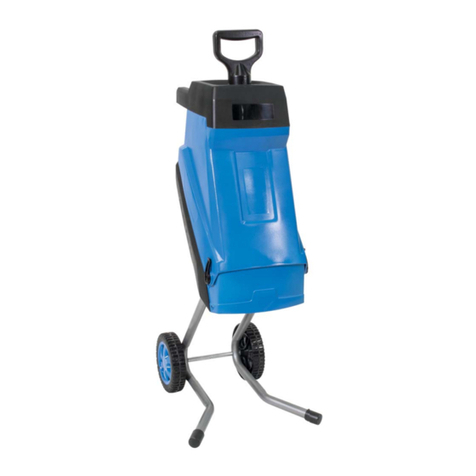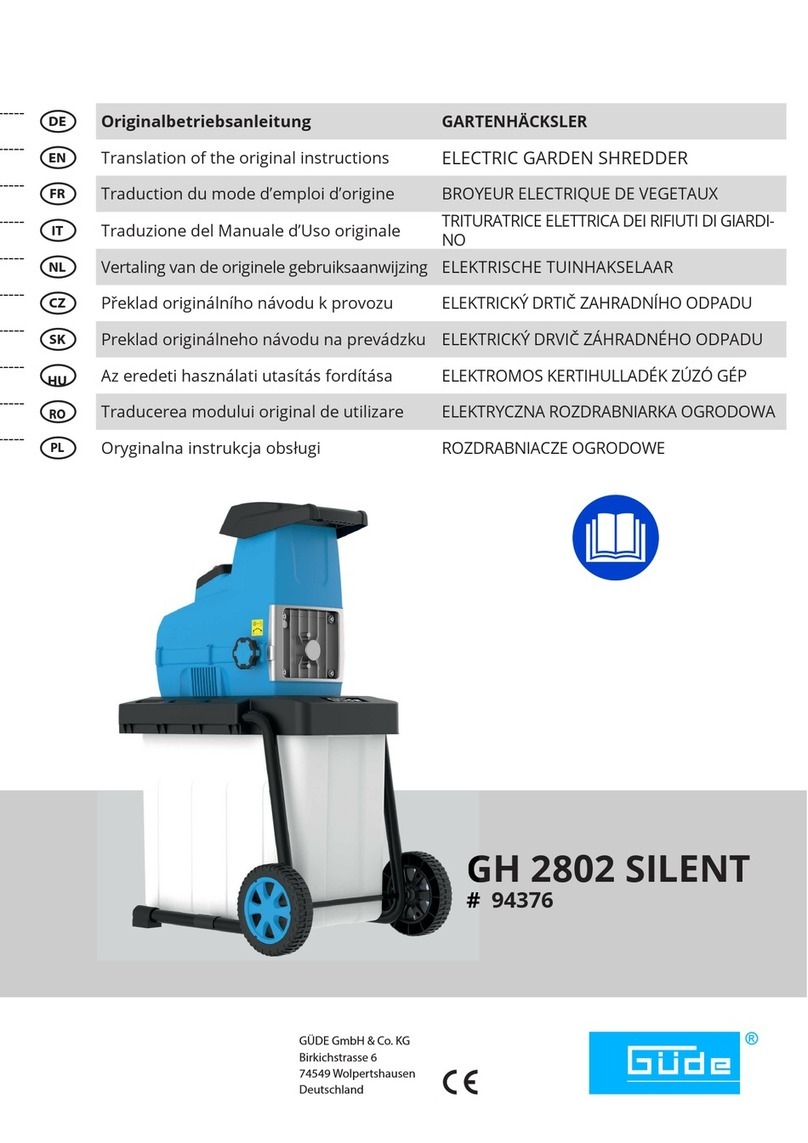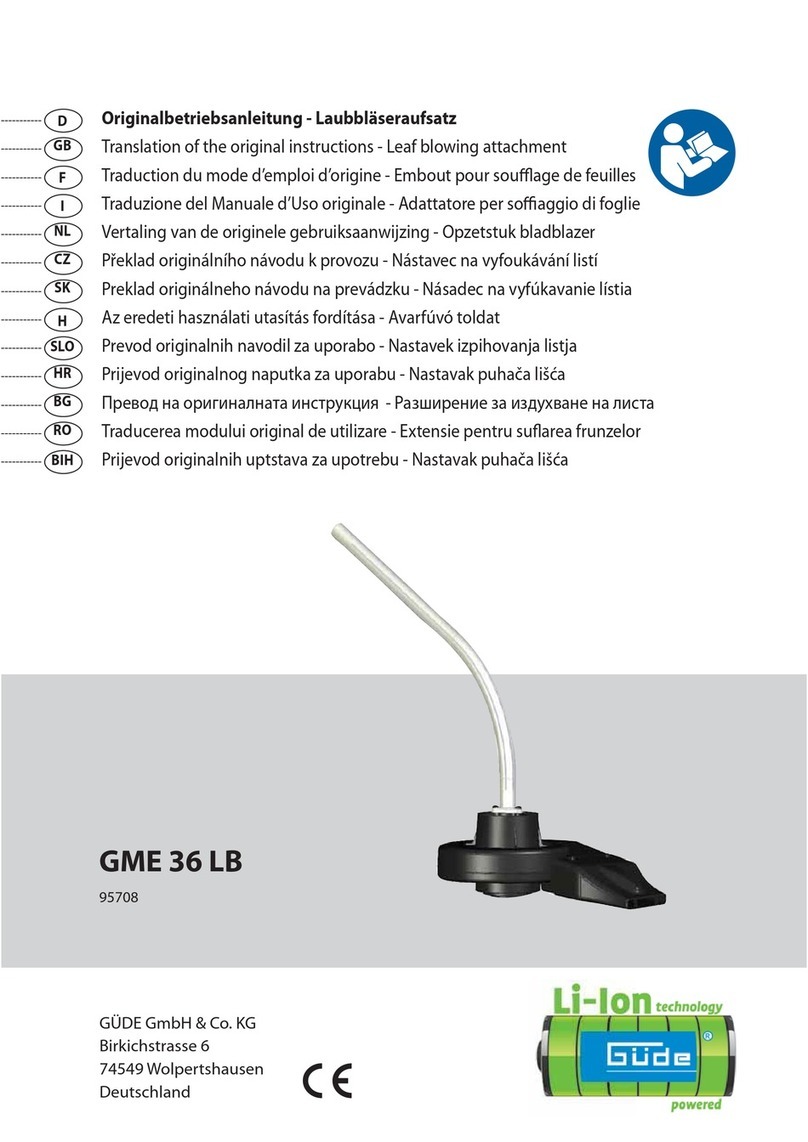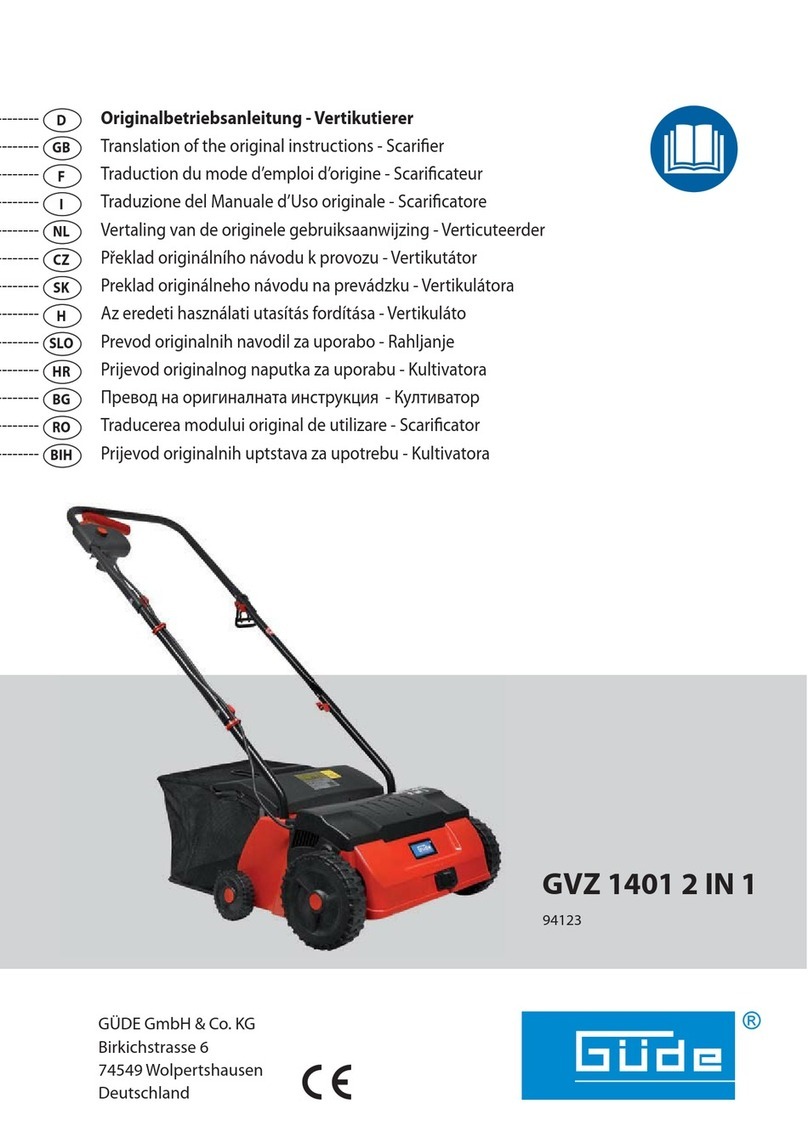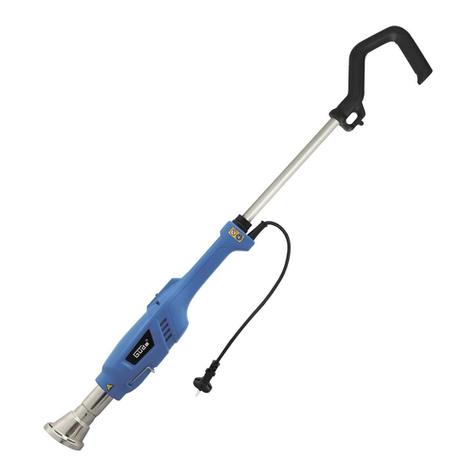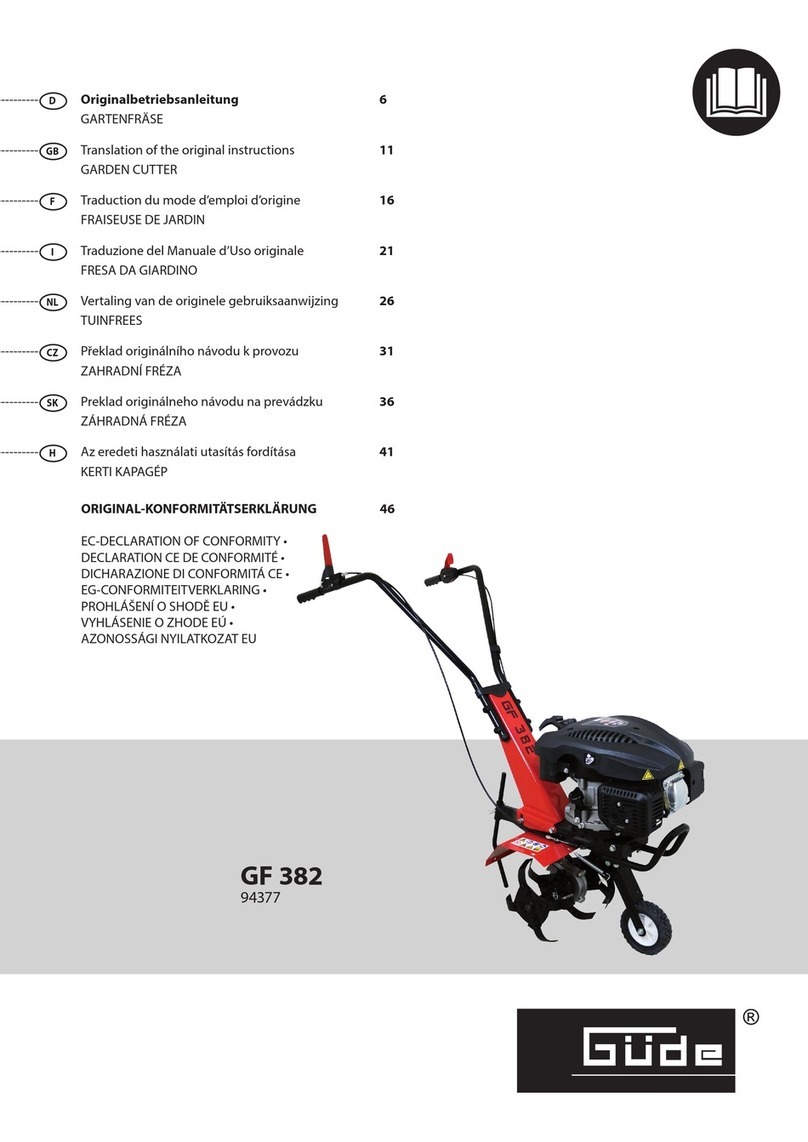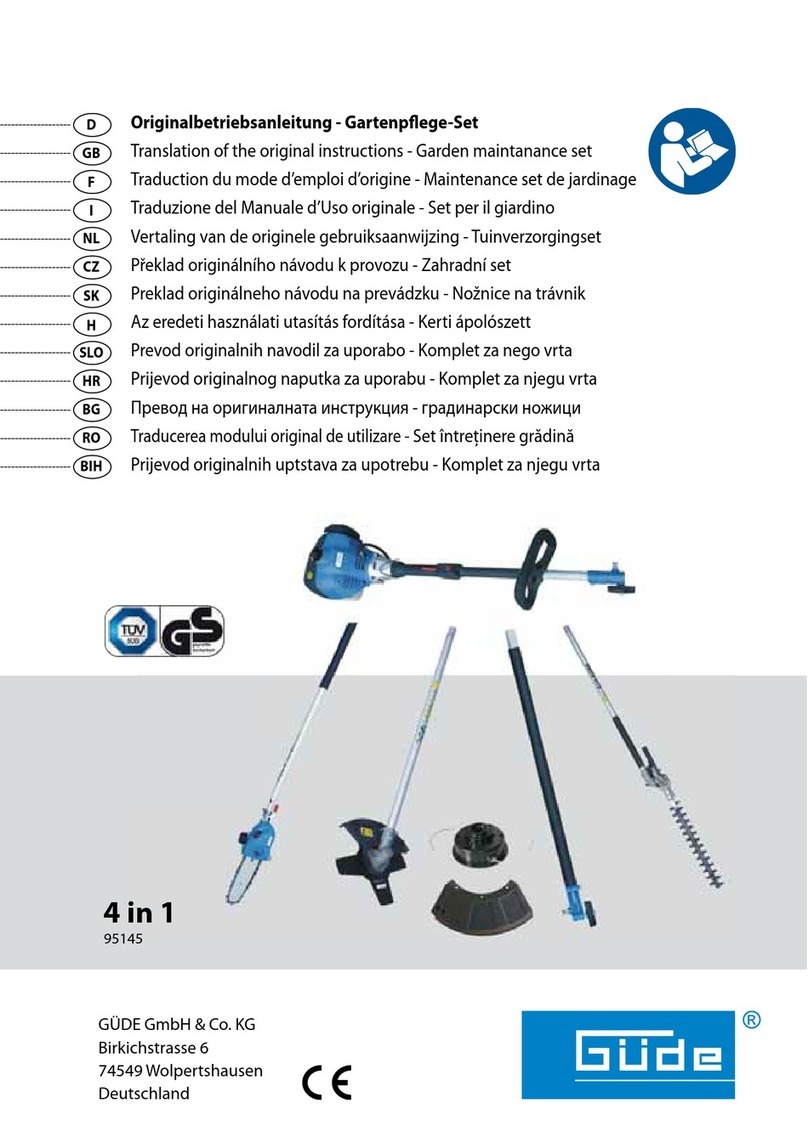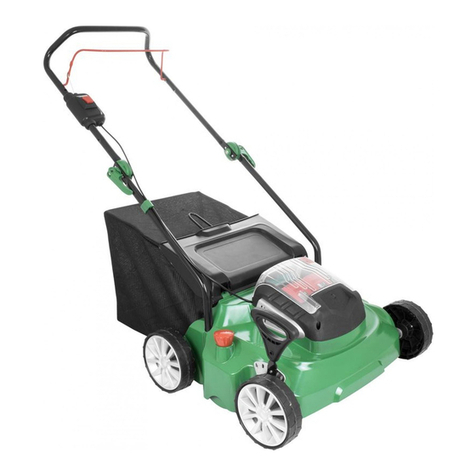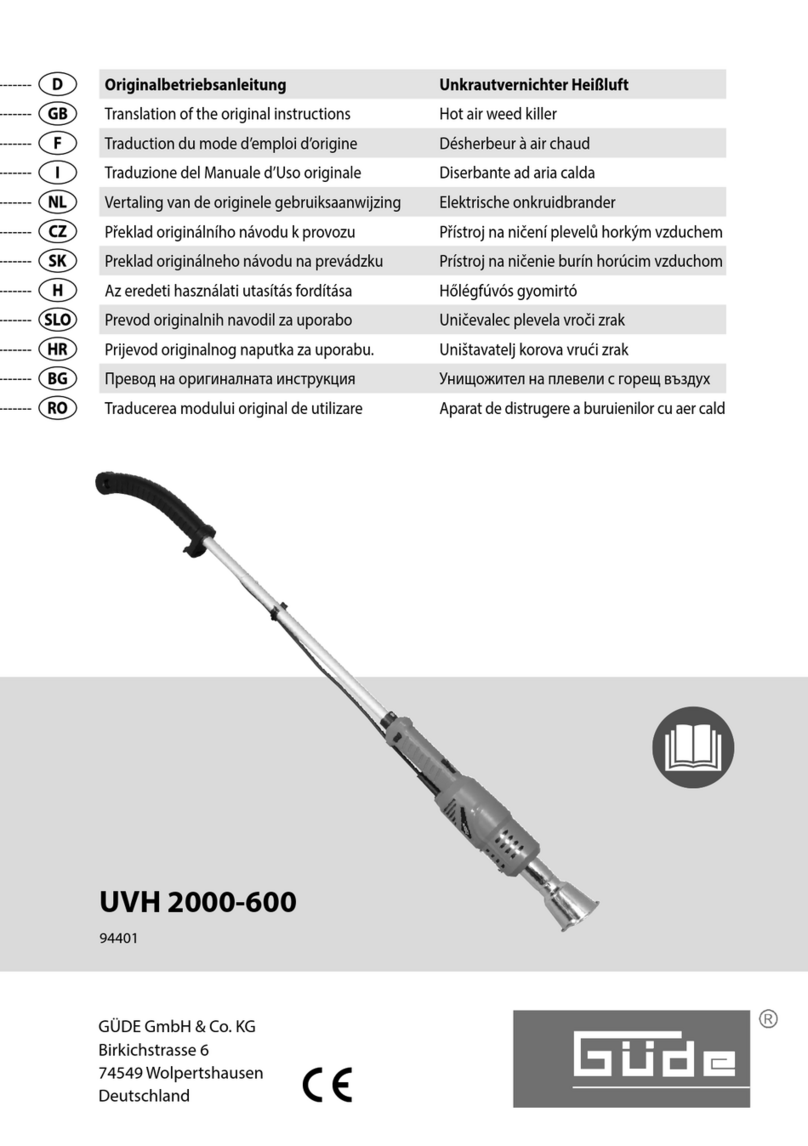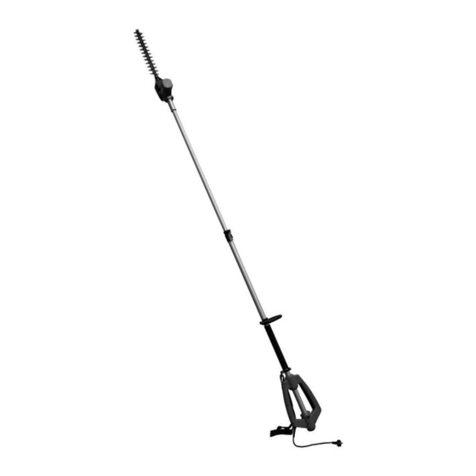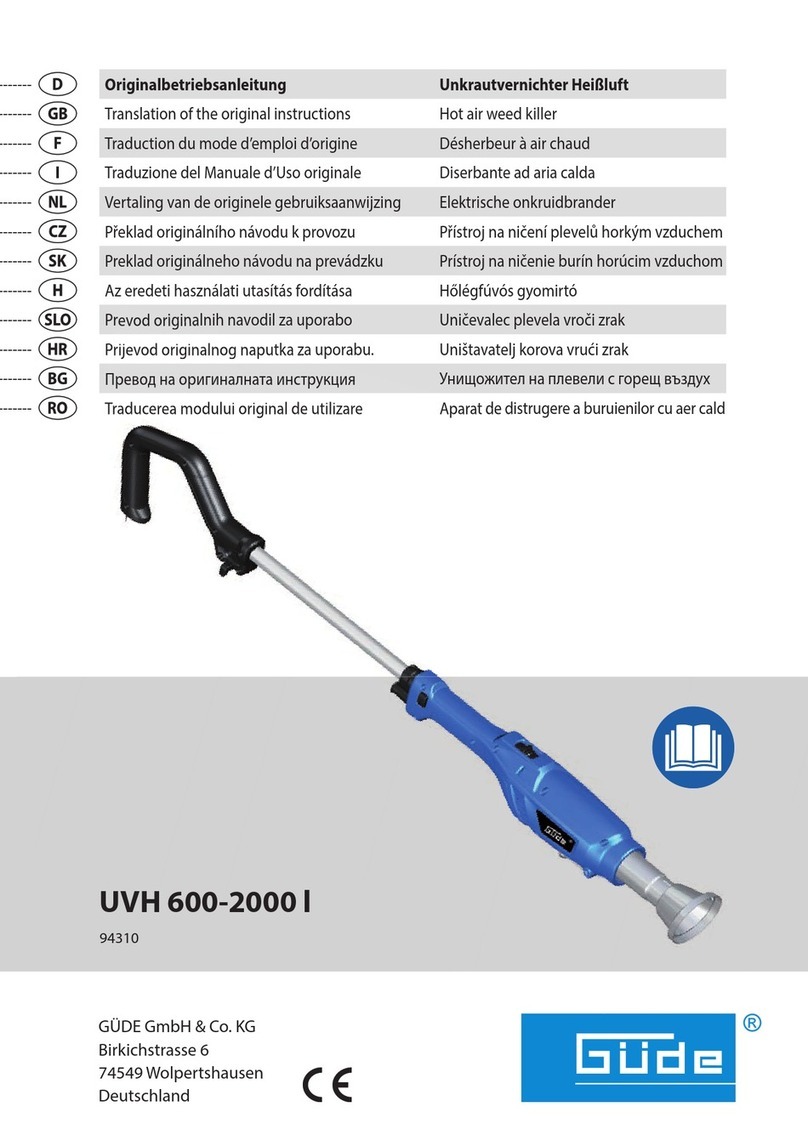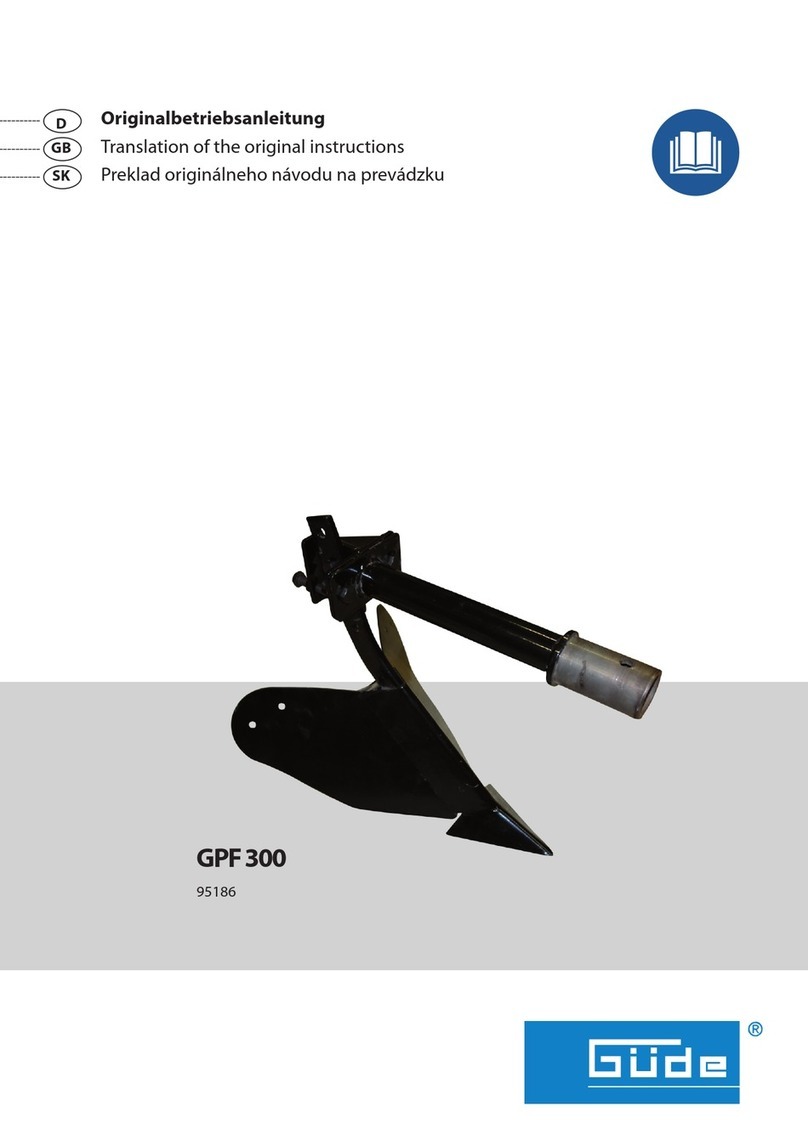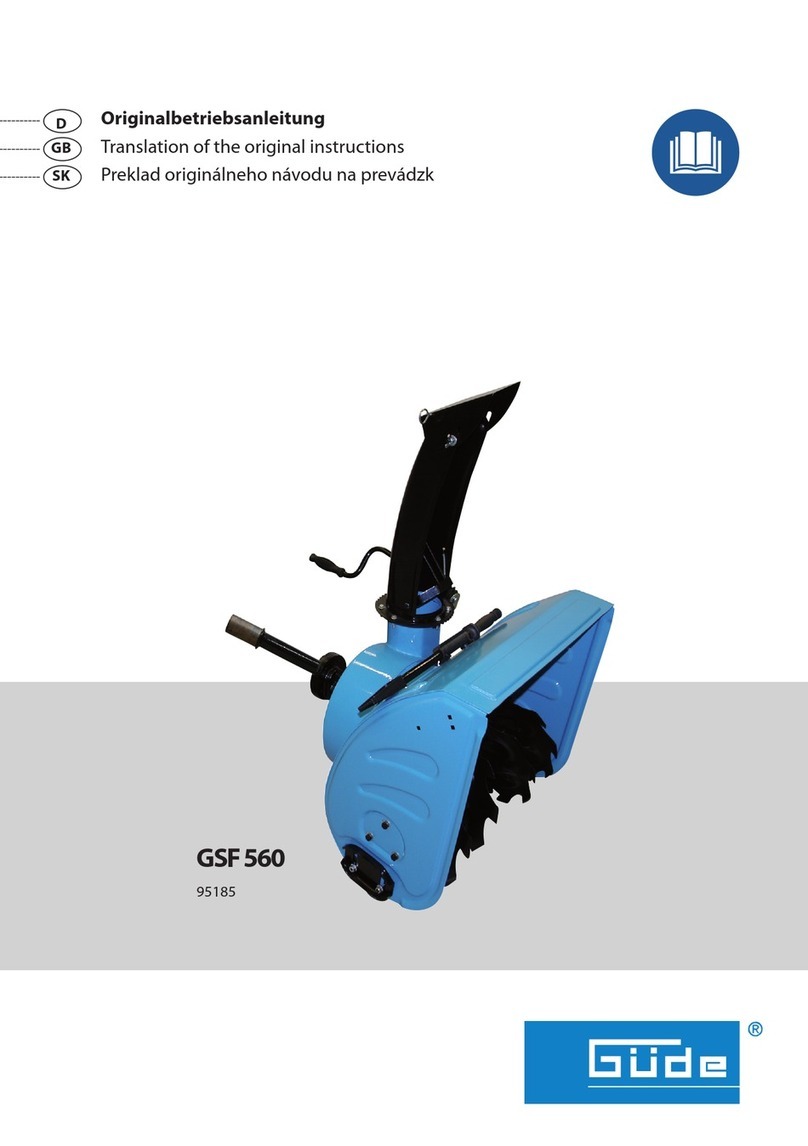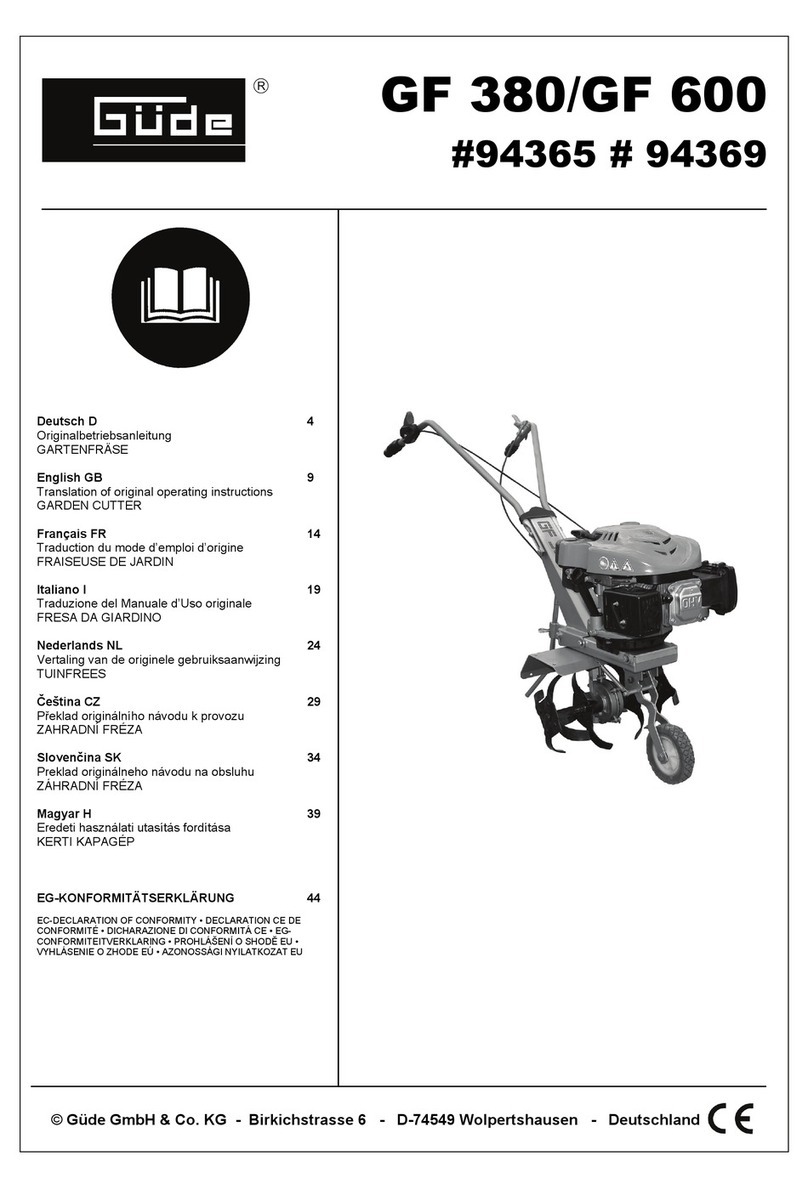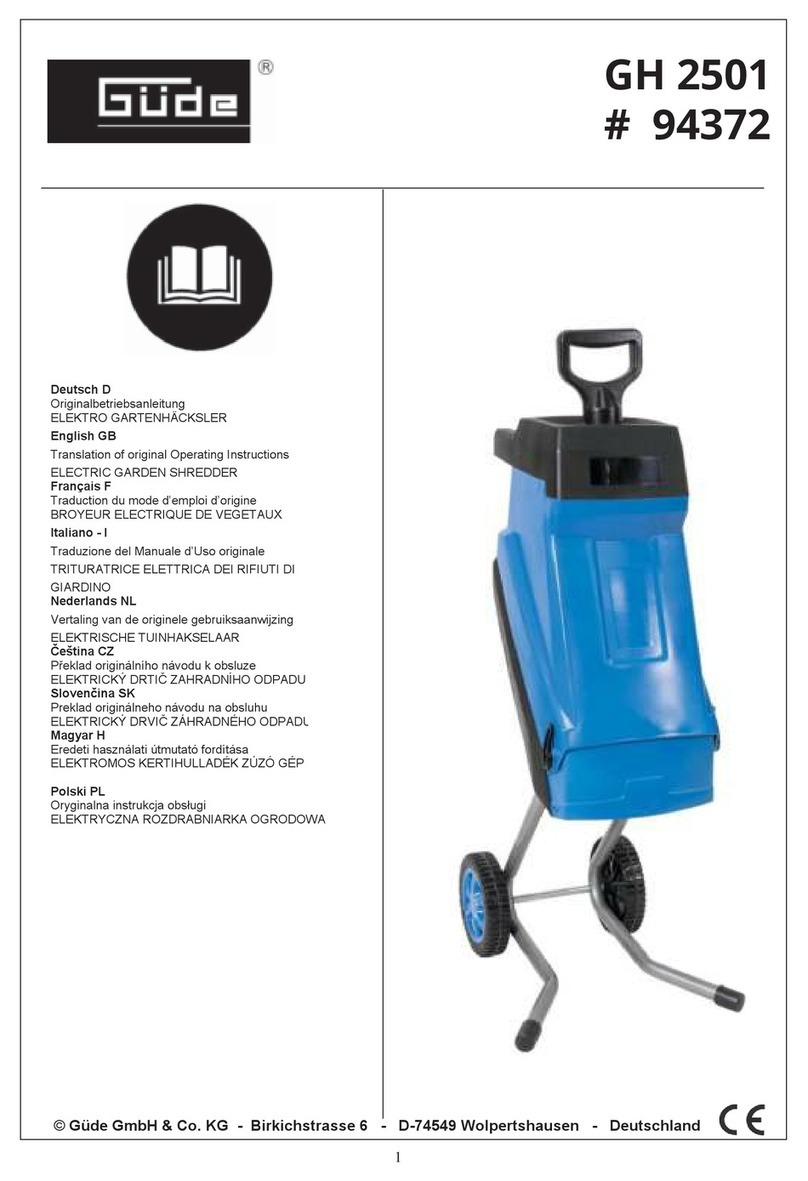Seien Sie besonders vorsichtig, wenn Sie die
Fahrtrichtung am Hang ändern.
Vertikutieren Sie nicht an übermäßig steilen Hängen.
Seien Sie besonders vorsichtig, wenn Sie den
Vertikutierer umkehren oder ihn zu sich heranziehen.
Halten Sie das Vertikutiermesser an, wenn der
Vertikutierer angekippt werden muss, bei einem
Transport über andere Flächen als Gras und wenn der
Vertikutierer von und zu der zu vertikutierenden Fläche
bewegt wird.
Benutzen Sie den Vertikutierer niemals mit
beschädigten Schutzeinrichtungen oder Schutzgittern
oder ohne angebaute Schutzeinrichtungen, z.B.
Prallbleche und/oder Moos- bzw.
Grasfangeinrichtungen.
Ändern Sie nicht die Regeleinstellungen des Motors
oder überdrehen Sie ihn nicht.
Starten Sie den Motor mit Vorsicht, entsprechend den
Herstelleranweisungen. Achten Sie auf ausreichenden
Abstand der Füße zu dem Vertikutiermesser.
Beim Starten oder Anlassen des Motors darf der
Vertikutierer nicht gekippt werden, es sei denn, der
Vertkutierer muss bei dem Vorgang angehoben
werden. In diesem Fall kippen Sie ihn nur so weit, wie
es unbedingt erforderlich ist, und heben Sie nur die
vom Benutzer abgewandte Seite hoch.
Führen Sie niemals Hände oder Füße an oder unter
sich drehende Teile. Halten Sie sich immer entfernt von
der Auswurföffnung.
Heben Sie oder tragen Sie niemals einen Vertikutierer
mit laufendem Motor.
Stellen Sie den Motor ab und ziehen Sie den
Kerzenstecker ab: Bevor Sie Blockierungen lösen oder
Verstopfungen im Auswurfkanal beseitigen. Bevor Sie
den Vertikutierer überprüfen, reinigen oder Arbeiten an
Ihm durchführen.
Wenn ein Fremdkörper getroffen wurde suchen Sie
nach Beschädigungen am Vertikutierer und führen Sie
die erforderlichen Reparaturen durch bevor Sie erneut
starten und mit dem Vertikutierer arbeiten.
Falls der Vertikutierer anfängt ungewöhnlich stark zu
vibrieren, ist eine sofortige Überprüfung erforderlich.
Stellen Sie den Motor ab wenn Sie sich vom
Vertikutierer entfernen oder bevor Sie nachtanken.
Der Benzinhahn ist zu schließen: Position OFF oder 0.
Bestimmungsgemäße Verwendung
Was ist Vertikutieren?
Vertikutieren ist eine Tiefenreinigung des Rasens. Der
Vertikalschnitt befreit den Rasen von Filz, Moos und flach
wachsendem Wildkraut. Luft, Wasser und Nährstoffe können
wieder zu den feinen Rasenwurzeln vordringen.
Warum sollte vertikutiert werden?
Die unterschiedlichen Witterungsperioden im Verlauf des Jahres
führen zu Ablagerungen von abgestorbenen und vertrockneten
Gräsern und Moos, die zum Verfilzen des Rasens führen. Die
Graswurzeln können Nährstoffe, Wasser und Luft nicht mehr in
ausreichender Menge aufnehmen. Der Rasen verkümmert. Der
Vertikalschnitt öffnet den Boden, entfernt Verfilzungen und sorgt
so für die Voraussetzungen einer besseren Nährstoffversorgung
für das Gras.
Wie wird vertikutiert?
Bei stark verfilzter Grasfläche sollte einmal längs und einmal quer
vertikutiert werden. Diese Arbeiten sollten zwei Mal im Jahr
durchgeführt werden. Die besten Zeitpunkte sind im Frühjahr,
wenn der Boden nicht mehr gefroren ist und der Spätsommer bis
Ende September. Danach sollte nicht mehr vertikutiert werden,
damit die Widerstandskraft des Rasens für einen möglichen
strengen Winter erhalten bleibt. Das ausgeworfene Material muss
auf jeden Fall von der Rasenfläche entfernt werden. Nach dem
Vertikutieren ist darauf zu achten, dass der Boden 4 bis 5 Tage
selbst an der Oberfläche nie
austrocknet. Damit kein Ausbrennen durch starke
Sonneneinstrahlung erfolgt, muss bei Trockenheit intensiv
beregnet werden. Der Benzin Vertikutierer ist für die private
Benutzung im Haus- und Hobbygarten geeignet. Als Vertikutierer
für den privaten Haus- und Hobbygarten werden solche angesehen,
deren jährliche Benutzung in der Regel 50 Stunden nicht übersteigen
und die vorwiegend für die Pflege von Gras oder Rasenflächen
verwendet werden, nicht jedoch in öffentlichen Anlagen, Parks,
Sportstätten sowie nicht in der Land- und Forstwirtschaft. Die
Einhaltung der vom Hersteller beigefügten Gebrauchsanweisung ist
Voraussetzung für den ordnungsgemäßen Gebrauch des
Vertikutierers. Die
Gebrauchsanweisung enthält auch die Betriebs-, Wartungs- und
Instandhaltungsbedingungen.
Achtung! Wegen körperlicher Gefährdung des Benutzers darf der
Vertikutierer nicht zu folgenden Arbeiten eingesetzt werden:
Zum Trimmen von Büschen, Hecken und Sträuchern, zum Schneiden
und Zerkleinern von Rankgewächsen oder Rasen auf
Dachbepflanzungen oder in Balkonkästen und zum Zerkleinern von
Baum- und Heckenabschnitten. Ferner darf der Vertikutierer nicht als
Motorhacke verwendet werden zum Einebnen von
Bodenerhebungen, wie z.B. Maulwurfshügel. Aus Sicherheitsgründen
darf der Vertikutierer nicht als Antriebsaggregat für andere
Arbeitswerkzeuge und Werkzeugsätze jeglicher Art verwendet
werden.
Restgefahren und Schutzmaßnahmen
Unangemessene örtliche Beleuchtung
Mangelhafte Beleuchtung stellt ein hohes Sicherheitsrisiko dar.
Sorgen Sie bei der Arbeit mit dem Gerät immer für ausreichende
Beleuchtung.
Entsorgung
Die Entsorgungshinweise ergeben sich aus den Piktogrammen die
auf dem Gerät bzw. der Verpackung aufgebracht sind. Eine
Beschreibung der einzelnen Bedeutungen finden Sie im Kapitel
„Kennzeichnung“.
Anforderungen an den Bediener
Der Bediener muss vor Gebrauch des Gerätes aufmerksam die
Bedienungsanleitung gelesen haben.
Qualifikation
Außer einer ausführlichen Einweisung durch eine sachkundige
Person ist keine spezielle Qualifikation für den Gebrauch des Gerätes
notwendig.
Mindestalter
Das Gerät darf nur von Personen betrieben werden, die das 16.
Lebensjahr vollendet haben. Eine Ausnahme stellt die Benutzung als
Jugendlicher dar, wenn die Benutzung im Zuge einer
Berufsausbildung zur Erreichung der Fertigkeit unter Aufsicht eines
Ausbilders erfolgt.
Montage / Erstinbetriebnahme
Entnehmen Sie den Vertikutierer aus der Verpackung und montieren
Sie zuerst den unteren, dann den oberen Holm mit der mitgelieferten
Schrauben und Griffmuttern. Setzen Sie nun den Moosfangsack ein,
er lässt sich bei angehobener Abdeckklappe in das Gerätegehäuse
einhängen.
Bedienung (Abb. 1-4)
Achtung vor jeder Inbetriebnahme Ölstand kontrollieren!
Die Qualität des Motoröls ist entscheidend für korrekte
Triebwerksleistung und Nutzungsdauer. Verwenden Sie nur
geeignete, hochwertige Schmierstoffe, ungeeignete Schmierstoffe
zerstören das Gerät und führen zum sofortigen erlöschen der
Garantieleistungen (empfehlenswert ist ein teilsynthetischer
Mehrbereichsschmierstoff der Spezifikation SAE 10 W 40). Aus
auslieferungs-technischen Gründen kann es sein, dass sich in dem
Gerät kein oder nur wenig Motoröl befinden (Füllung für





